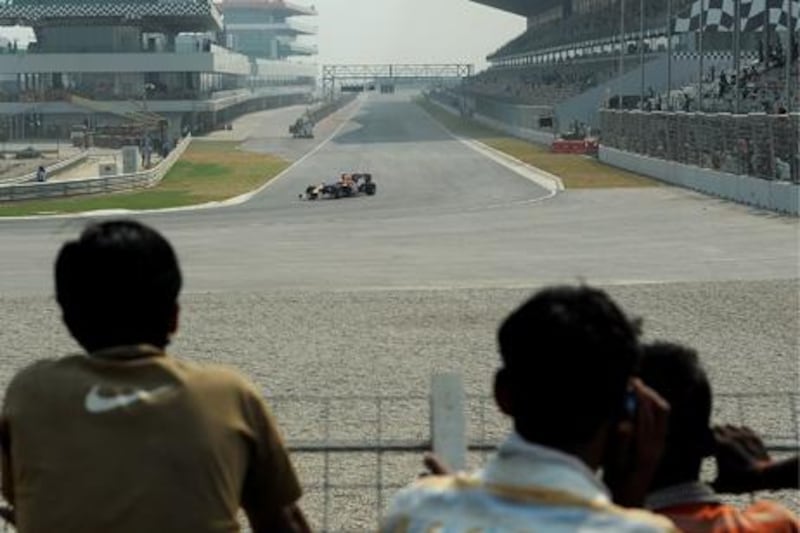The excess of Formula One is directly juxtaposed with the squalor of slum life.
Instead of Lewis Hamilton's multi-million dollar McLaren-Mercedes, shopkeeper Irvine Sharma has a rust-ridden bicycle, while Mark Webber's canines would likely not be too keen on the diet of Ragee, the scabrous dog that survives on dead grass and rubbish.
The township in Greater Noida is so close to the media hotels that even a lift there is unnecessary.
Walking into a slum, especially one home to around 150 people, is like walking on to a movie set, but without the lights, the cameras and the comfort that comes with knowing everything is artificial.
This is real life: as heroic as it is heartbreaking.
"I work, I make money and I feed my family," said Ramsavak Singhyadav, who earns R7,000 (Dh445) each month by guarding the slum with an iron fist and a bamboo cane.
With around 30 per cent of the Indian population living on less than Dh5 a day, questions have been raised whether it is ethical for Formula One, with its untold riches and million-dollar budgets, hosting its inaugural Indian Grand Prix this afternoon, to be taking place here.
"People comment on the contrast of something like F1 within the communities of India, but if we don't come here how can we help?" said Ross Brawn, the Mercedes GP team principal.
"How can we contribute to making things move forward if F1 stays away from India? What solution does that provide? It doesn't provide any solutions, and maybe by F1 coming to India we can contribute in a small way to the development of India as a nation."
With the possible exception of Brazil's Interlagos circuit, no race on the 19-event calendar provides proof of such disparity in wealth. Felipe Massa, Ferrari's Brazilian driver, however, is positive F1 can make a difference.
"If we go back 20-30 years, we saw many things like that in Brazil, but it has improved a lot and I think the same will happen here," he said. "Each year we come back it will be different."
Just like F1, Ramsavak is new to Greater Noida. Having arrived from the state of Madhya Pradesh, he is here to help the construction company behind the nearby hotel projects. The city is experiencing an infrastructural boom courtesy of the nearby Buddh International Circuit, host of today's race.
Half-built hotels pepper the horizon and the windows of a planned shopping mall feature billboards displaying soon-to-arrive designer labels instead of glass.
"When you come back next year, this will be all finished and full of people," said Rahul Sharma, my concierge-turned-translator for the day.
He explains the families who live in the slum are transient nomads, going wherever the work takes them.
Vicky Chandhok, the president of India's motor sports federation, said more than 10,000 people helped to build the US$400 million (Dh1.46 billion) circuit and that it will employ a further 1,400 staff.
"Their families will get a better education and a better living, so when all is said and done I can't see a negative from this," he said.
When Ramsavak was asked if he knows about Formula One, he replied: "Is it a horse race?" as he smiled and flattened down his oiled grey hair.
Rahul elaborated: "The reason these families are here is because they are helping to construct a building for Formula One, but they don't know what Formula One is. It doesn't have any relevance to them. When they get their money, they spend it on food and medicine."
Irvine Sharma is the local shop keeper. He sleeps in his shop on top of a flattened cardboard box and uses a small stone fireplace for cooking. The corrugated iron panel that acts as a shop door is inscribed with chalk renderings in Hindi.
Rahul explained the markings are related to prescriptions provided to prevent polio, a crippling disease the Indian health ministry reported earlier this week was close to eradicating. Fernando Alonso, Massa's teammate at Ferrari, attended a polio drive on Wednesday.
Polio is one thing, but Vijay Mallya, the billionaire who owns Force India, said India cannot afford to wait for poverty to be eradicated.
"This is a progressive country, we have a strong, growing, large economy. The government is doing all it can to address the needs of the poor or the underprivileged people, but India must move on," he said. "The Commonwealth Games were held here in India, now it's Formula One. I'm sure there will be several more global events in our country, because this is a world-class country in many ways. We have our problems, but those are being addressed."
Ramsavak, dressed in his tattered blue security shirt, lives in a different reality to Mallya, but each man's priorities remain the same.
"India is an expensive country, the cost of living is high," said Ramsavak. "I earn 7,000 rupees per month and spend it all on food. If my children get sick, we just eat less."
His salary is paid by the construction company building hotels on the promise of Formula One's presence.
Follow
The National Sport
on
[ @SprtNationalUAE ]
& Gary Meenaghan on
[ @GMeenaghan ]





